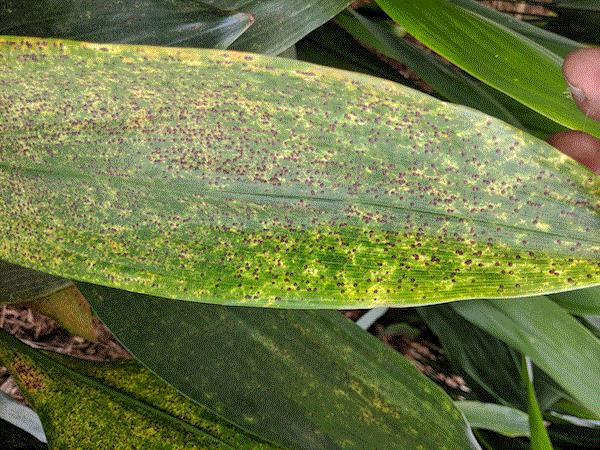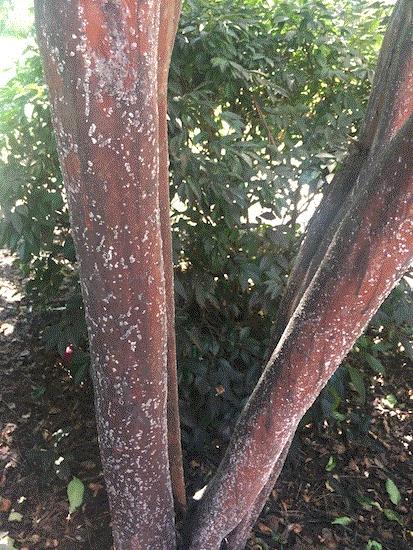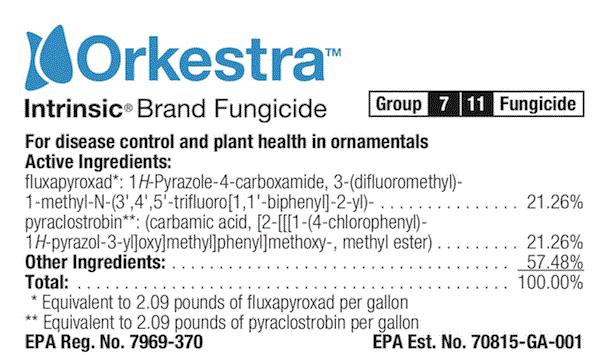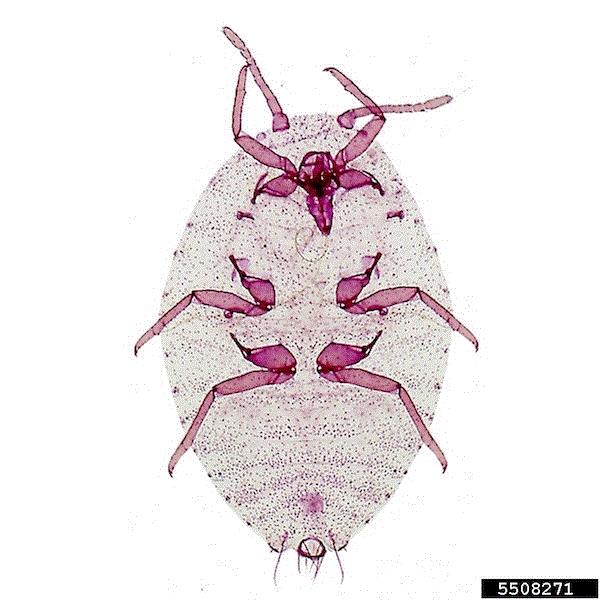What the ... ?
Winchell Dowe, who manages the grounds at the Greenville-Spartanburg International Airport, sent me a series of pictures of scale insects found on cast iron plants. I thought that was pretty interesting because cast iron plant, also known as iron plant or ballroom plant, is pretty darn hardy. Chill, heat and drought don't hurt it much, that’s why it’s a popular indoor plant that everyone loves to forget about.
Winchell thought that cast iron plants don't have pests, and he was almost right! Scale insects, mealybugs and spider mites are just about the only pests I’ve seen on cast iron plants. Even then, the infestation is usually light. So, seeing such a heavy infestation was something new.

(Photo credit: Winchell Dowe)
What scale insect species is attacking the cast iron plants?
The cast iron plants can survive cold weather, even outdoors. But, I can't say the same about myself, and my wife’s dog, Sake. Temperatures dropped to 36F on Sunday morning. I was in my flannel pajamas, and Sake had her feet tucked under herself. Poor puppy. My better half, texting from a girls’ party at a beach house, believed that the dog would not survive if she had to wait for me to turn on the heater. Hey, I’m just following President Jimmy Carter’s example of turning the heater dial down to 65F and wearing extra sweaters to save fuel, some Benjamins, and the Earth! Ah, the good old days.


IR-4 publishes scale and mealybug efficacy summary
Speaking of scale insects, IR-4 recently published a summary of its research projects that evaluated the efficacy of various insecticides against scale insects and mealybugs. This document summarizes the results of 86 trials against 23 scale and mealybug species conducted between 2004 and 2018.
Warning: Read this summary at your own risk. If you are looking for a silver bullet among the pages, you can just give up right now. Product efficacy varies depending on insect species, application method, rates, timing and even plant species. I, who live and think about scale insects, still haven't caught that silvery shimmer in the muddy water. I tip my hat to Cristi Palmer and Ely Vea of the IR-4 Project for their monumental attempt to summarize this large body of information.
I think the best way for me to summarize the 151-page summary is to look at only the major pest species.
Crapemyrtle bark scale: One study demonstrated reliable suppression of populations with Distance (pyriproxyfen), Safari (dinotefuran), Talus (buprofezin) and Altus (flupyradifurone).
Calico scale: Foliar and soil applications of dinotefuran (Safari and Transect) didn't reduce adult numbers, but the treatments reduced nymph densities weeks or months after the treatment. When sprayed against crawlers or nymphs, repeated applications of Distance, Safari, Talstar (bifenthrin) and Mainspring (cyantraniliprole) could significantly reduce or suppress scale insect populations.
Florida wax scale: Foliar and drench applications of neonicotinoids (acetamiprid, clothianidin, dinotefuran, imidacloprid and thiamethoxam) provided good to excellent control.

Euonymus scale: Generally, foliar applications of Safari, Tristar (acetamiprid), horticultural oil and insect growth regulators (Talus and Distance) resulted in lower scale insect populations.
Pine needle scale and tea scale: Drench application of Safari, as well as foliar application of Safari, Flagship (thiamethoxam), Tristar, Distance, Talus, Kontos (spirotetramat), Mainspring, XXpire (sulfoxaflor + spinetoram), and horticultural oil provided good efficacy.
Citrus mealybug: Drench application with Safari, and foliar application with neonicotinoids (Flagship, Safari and Tristar), insect growth regulators (Talus and Distance), Kontos, Rycar (pyrifluquinazon), Pradia (cyclaniliprole + flonicamid), and horticultural oil provided good control.
Madeira mealybug: Results are similar to those of citrus mealybug. Foliar application of Orthene (acephate) also worked well.
There are a lot more species and information I cannot include here. If you are interested in reading the efficacy summary, click here. Remember that efficacies of insecticides against scale insects and mealybugs are at their best when you target crawlers, make repeated applications, use a surfactant such as a spreader-sticker and achieve thorough coverage of the canopy. For most home gardeners, and even professional growers and nursery staff, repeated applications of horticultural oil just might be the best solution for most species.
Did I ever tell you how much I love scale insects and mealybugs? Yes, I’m madder than the Mad Hatter.

Crop safety summary for Orkestra Intrinsic fungicide
IR-4 also published a crop safety summary of fluxapyroxad + pyraclostrobin, better known as Orkestra Intrinsic fungicide by BASF. In the turf market side, the combo product is called Lexicon Intrinsic fungicide. Orkestra and Lexicon Intrinsic are 7-11 combos (fluxapyroxad = FRAC 7 and pyraclostrobin = FRAC 11).
Orkestra Intrinsic is an effective fungicide against anthracnose, botrytis, downy mildew, powdery mildew, rust and stem, twig and petal blight. It’s commonly used during production in greenhouses and nurseries, and in maintenance in landscapes. Lexicon Intrinsic fungicide is used in golf courses, parks, athletic fields, lawns and sod farms against common foliar diseases, such as dollar spot, brown patch and gray leaf spot.

IR-4 and its collaborating researchers conducted 78 trials to evaluate the phytotoxicity of foliar applications of fluxapyroxad + pyraclostrobin on 34 plant species between 2014 and 2018. Fungicide was applied three times (at 14-day intervals) at 8, 16 and 32 fl. oz. per 100 gallons. (Label rates were between 4 to 11 fl. oz. per 100 gallons, depending on the target, use site and application method.)
No plant species were injured at 8 fl. oz. per 100 gallons. All but two plant species exhibited minimal or no injury at higher rates. In one study, flowering dogwood and New Guinea impatiens exhibited significant injury at 16 and 32 fl. oz. per 100 gallons. If I plan to use Orkestra Intrinsic fungicide on or near flowering dogwood or New Guinea impatiens, I will run a quick phytotoxicity test on my own by spraying a small group of plants at the desired rate and see what happens in the next three days.
Orkestra Intrinsic also allows drench applications in greenhouses and nurseries. Phytotoxicity on nine plant species was evaluated in 2016 and 2018. Drench treatments were applied once at 10, 20 and 40 fl. oz. per 100 gallons. Fifteen trials were conducted, and none of them reported significant phytotoxicity of Orkestra Intrinsic on any of the crop species tested.
You can find a copy of the crop safety summary for Orkestra Intrinsic by clicking here.

Answer to "What the ... ?"
So, what are those scale insects on the cast iron plants? Well, hell if I know for sure. I can guess, though. I think those are false Florida red scale, a common armored scale species found on lots of foliage plants and shrubs in my neck of the woods. I’ll need some samples to identify to species, but identification is usually a two-week process.
Really—identifying scale insects and mealybugs to species is a very time-consuming process. I have to first soak the bugs in a potassium hydroxide solution for 24 hours, then make a small incision on the side of the body, and push out all the bodily contents (which has turned to mush by the hydroxide at this time). I then put these empty exoskeletons or skins into acid fuchsin to dye overnight. After that, I take them out and clean them in water, then in a series of alcohol baths, then into a clove oil bath for another night. And finally, I can mount the skins on Canadian balsam on microscope slides. But wait, there’s more! I’ll have to dry the slides on a warm plate for a week. Oh, the anticipation!

OK, I didn't prepare this slide of an adult female papaya mealybug. It's just an example to show you how beautiful mealybugs can be when slide-mounted. (Photo credit: Alessandra Rung, USDA APHIS PPQ; bugwood.org)
The end result is the stuff of beauty. Yeah, I sort of think of myself as an artist. Don't rush a mad artist if you want your scale insect properly identified, okay?
Winchell has decided to remove the infested plants, which I think is a smart move. Often, when plants are so heavily infested, the only thing to do is to send them to the dump. Of course, you can also consult the new IR-4 scale insect and mealybug efficacy summary (see above) to find the best product for management.
By the way, I have some microscope slides drying right now. I think there is one cochineal scale species, one mealybug species, and ten to twelve thrips species. I’ll be ready to have a look and identify them next week. Is anyone insane enough to help?





See y'all next time!

JC Chong
Professor of Entomology at Clemson University
This e-mail received by 22,260 subscribers like you!
If you're interested in advertising on PestTalks contact Kim Brown ASAP!